Abstract
Bacteriuria associated with long-term urinary catheters (those in place for greater than or equal to 30 days) appears to be the most common nosocomial infection in U.S. medical care facilities. This bacteriuria is polymicrobial and dynamic and accompanied by fevers, catheter obstructions, bacteremias, and deaths. We compared the reporting by our research laboratory of bacteria present in urine from long-term-catheterized nursing home patients with that by two commercial laboratories. The commercial laboratories isolated significantly fewer bacterial species at 10(5) CFU/ml of urine specimen. Organisms well recognized as causes of urinary tract infections in noncatheterized patients (Escherichia coli, Proteus mirabilis, Klebsiella pneumoniae) were isolated in comparable frequencies by both the research and commercial laboratories. However, other organisms, including uncommon uropathogens like Providencia stuartii and Morganella morganii, which were actually among the most frequent bacteriuric species in these long-term-catheterized patients, were isolated significantly less frequently by the commercial laboratories. Reasons for the discrepancies are unclear but may involve use of different techniques. More complete reporting may lead to better understanding of the polymicrobial bacteriuria of long-term catheters and its associated complications. This, in turn, may result in improved patient care and infection control in nursing homes.
Full text
PDF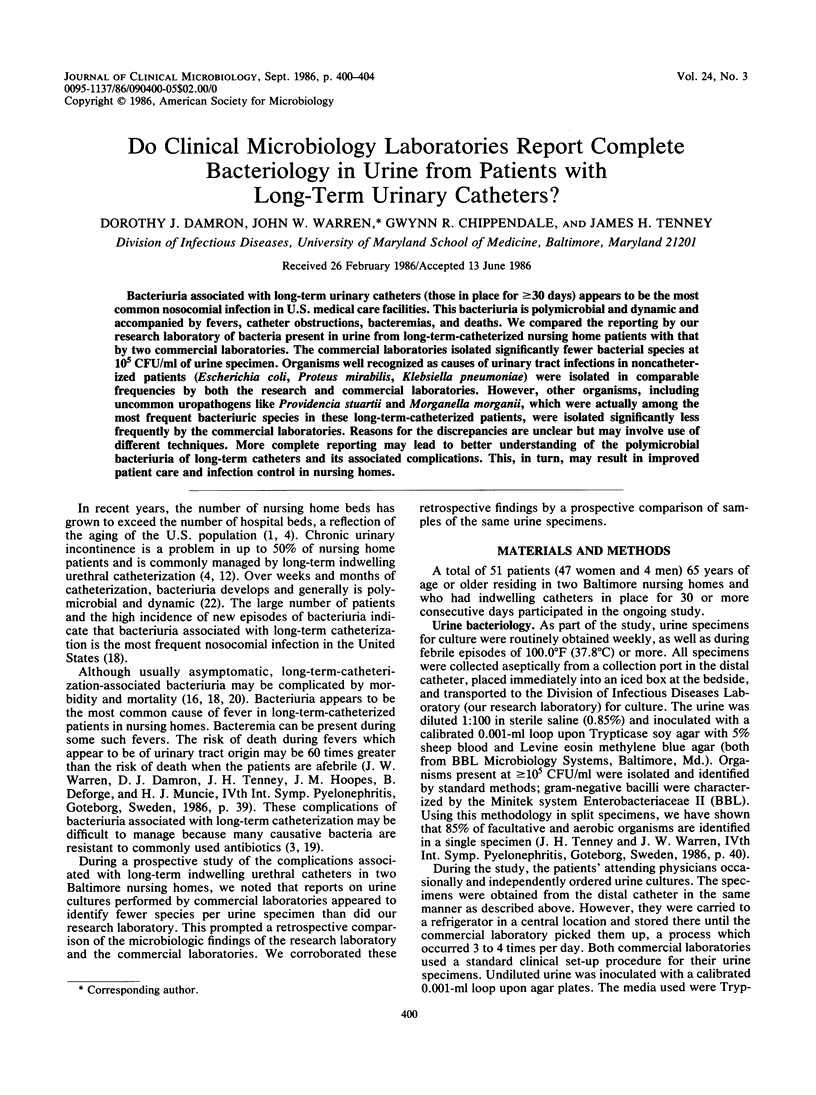
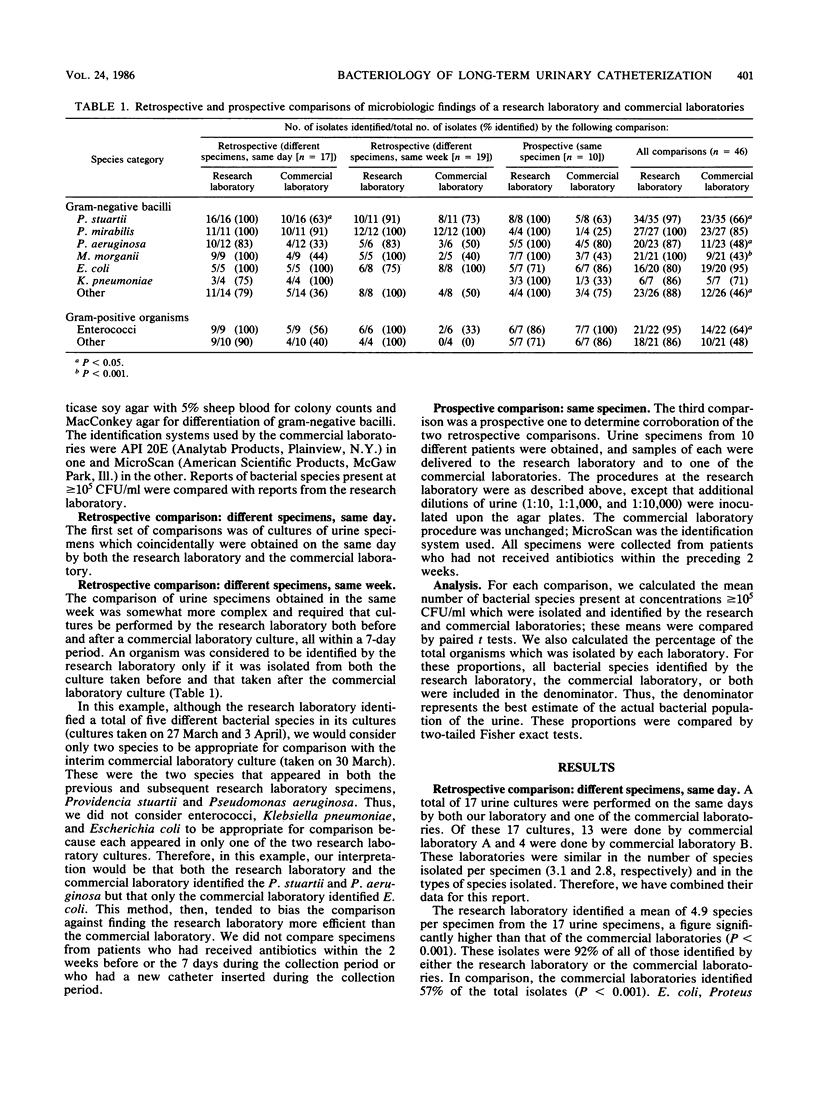
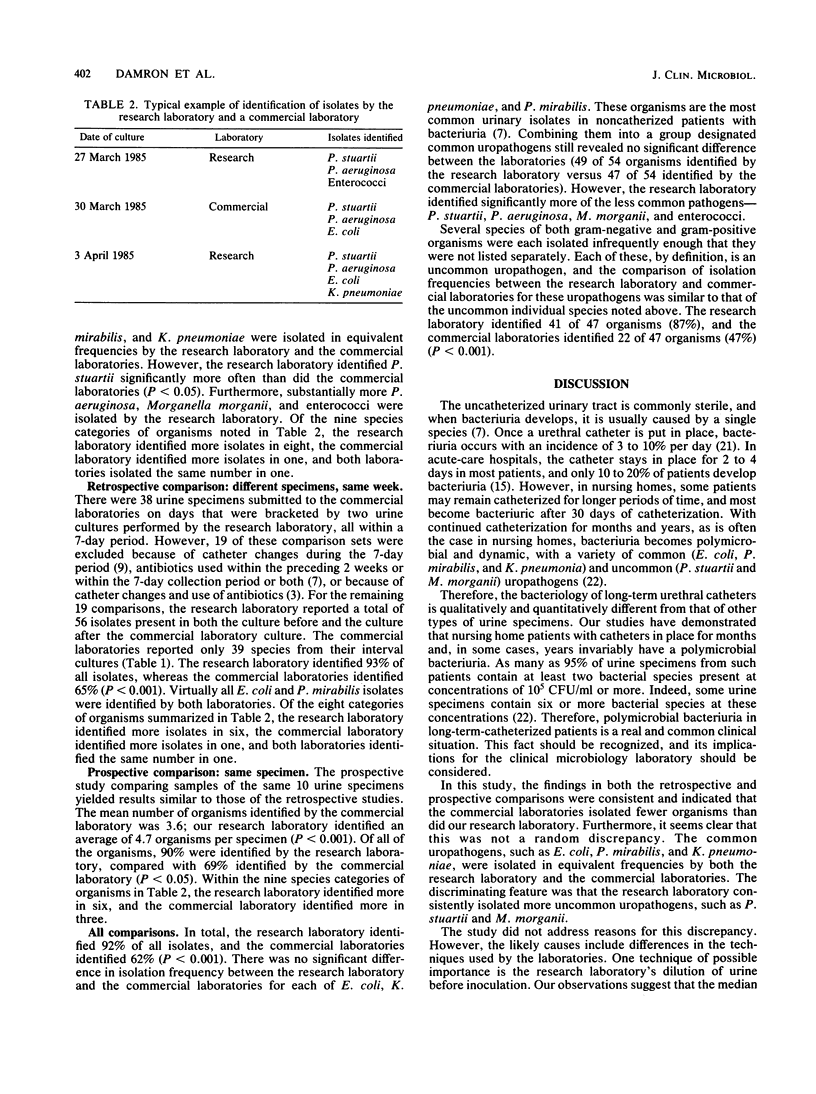
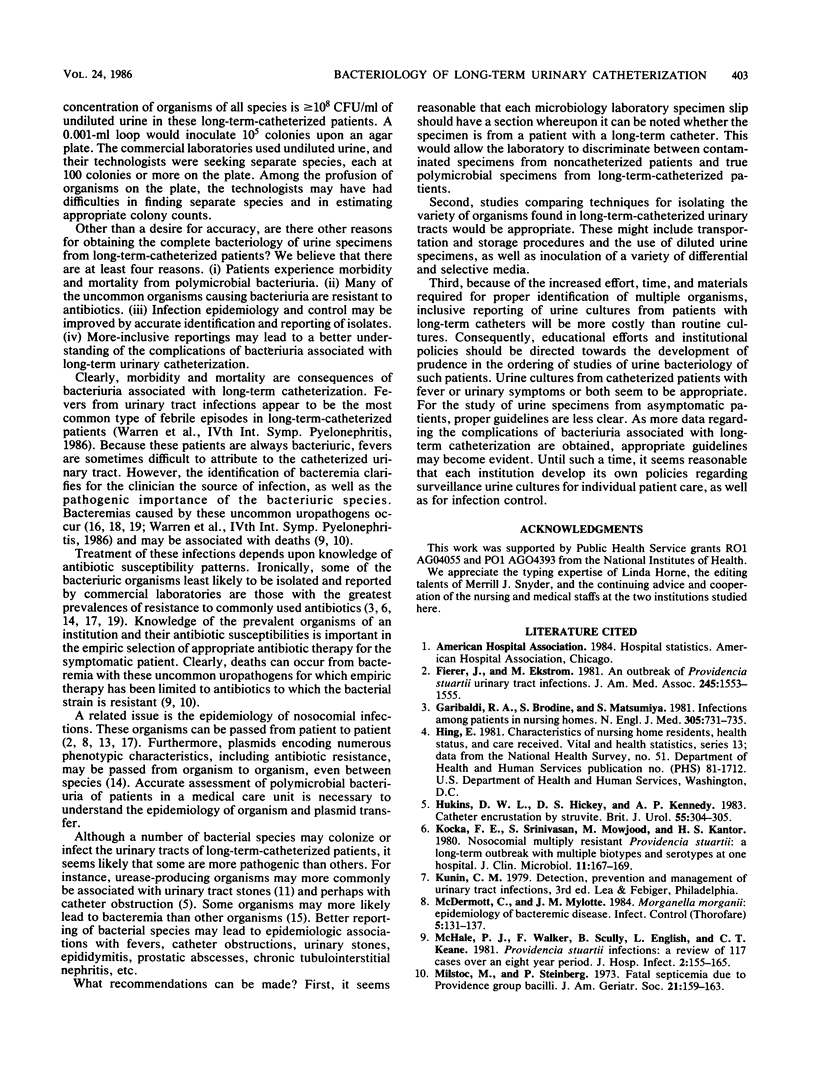
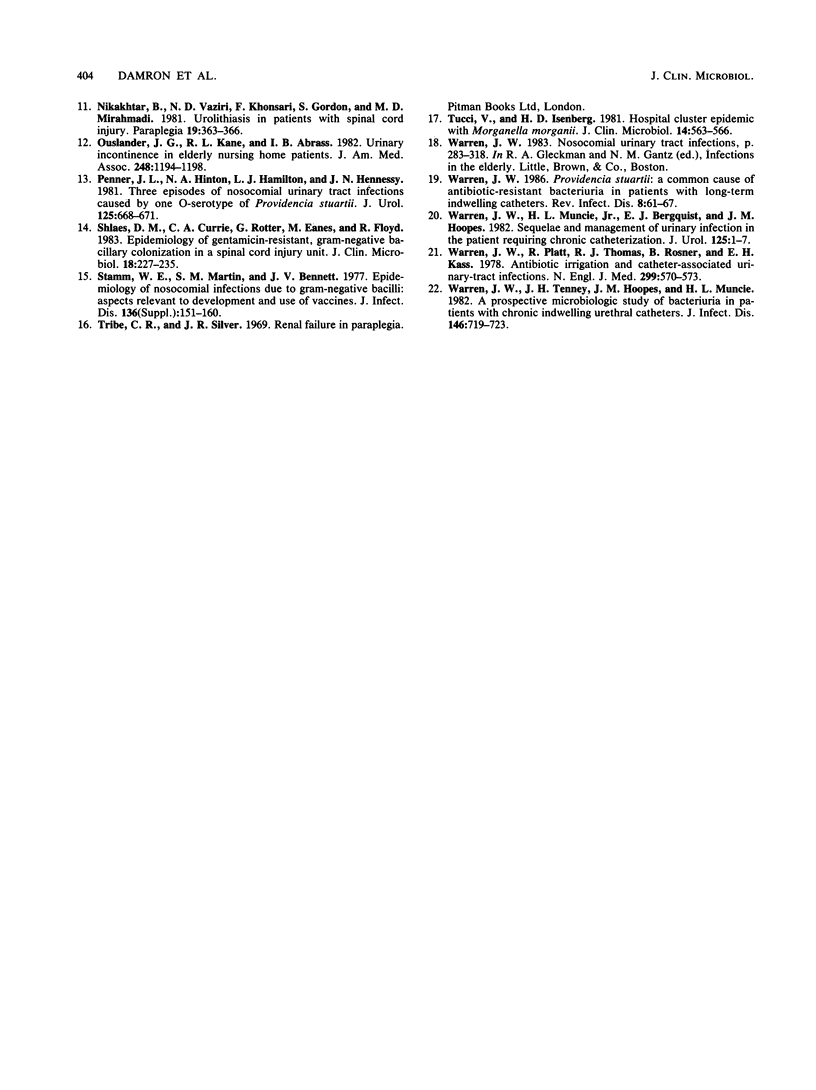
Selected References
These references are in PubMed. This may not be the complete list of references from this article.
- Fierer J., Ekstrom M. An outbreak of Providencia stuartii urinary tract infections. Patients with condom catheters are a reservoir of the bacteria. JAMA. 1981 Apr 17;245(15):1553–1555. [PubMed] [Google Scholar]
- Garibaldi R. A., Brodine S., Matsumiya S. Infections among patients in nursing homes: policies, prevalence, problems. N Engl J Med. 1981 Sep 24;305(13):731–735. doi: 10.1056/NEJM198109243051304. [DOI] [PubMed] [Google Scholar]
- Hukins D. W., Hickey D. S., Kennedy A. P. Catheter encrustation by struvite. Br J Urol. 1983 Jun;55(3):304–305. doi: 10.1111/j.1464-410x.1983.tb03304.x. [DOI] [PubMed] [Google Scholar]
- Kocka F. E., Srinivasan S., Mowjood M., Kantor H. S. Nosocomial multiply resistant Providencia stuartii: a long-term outbreak with multiple biotypes and serotypes at one hospital. J Clin Microbiol. 1980 Feb;11(2):167–169. doi: 10.1128/jcm.11.2.167-169.1980. [DOI] [PMC free article] [PubMed] [Google Scholar]
- McDermott C., Mylotte J. M. Morganella morganii: epidemiology of bacteremic disease. Infect Control. 1984 Mar;5(3):131–137. doi: 10.1017/s0195941700059993. [DOI] [PubMed] [Google Scholar]
- McHale P. J., Walker F., Scully B., English L., Keane C. T. Providencia stuartii infections: a review of 117 cases over an eight year period. J Hosp Infect. 1981 Jun;2(2):155–165. doi: 10.1016/0195-6701(81)90024-4. [DOI] [PubMed] [Google Scholar]
- Milstoc M., Steinberg P. Fatal septicemia due to Providence group bacilli. J Am Geriatr Soc. 1973 Apr;21(4):159–163. doi: 10.1111/j.1532-5415.1973.tb00868.x. [DOI] [PubMed] [Google Scholar]
- Nikakhtar B., Vaziri N. D., Khonsari F., Gordon S., Mirahmadi M. D. Urolithiasis in patients with spinal cord injury. Paraplegia. 1981;19(6):363–366. doi: 10.1038/sc.1981.68. [DOI] [PubMed] [Google Scholar]
- Ouslander J. G., Kane R. L., Abrass I. B. Urinary incontinence in elderly nursing home patients. JAMA. 1982 Sep 10;248(10):1194–1198. [PubMed] [Google Scholar]
- Penner J. L., Hinton N. A., Hamilton L. J., Hennessy J. N. Three episodes of nosocomial urinary tract infections caused by one O-serotype of Providencia stuartii. J Urol. 1981 May;125(5):668–671. doi: 10.1016/s0022-5347(17)55157-5. [DOI] [PubMed] [Google Scholar]
- Shlaes D. M., Currie C. A., Rotter G., Eanes M., Floyd R. Epidemiology of gentamicin-resistant, gram-negative bacillary colonization in a spinal cord injury unit. J Clin Microbiol. 1983 Aug;18(2):227–235. doi: 10.1128/jcm.18.2.227-235.1983. [DOI] [PMC free article] [PubMed] [Google Scholar]
- Tucci V., Isenberg H. D. Hospital cluster epidemic with Morganella morganii. J Clin Microbiol. 1981 Nov;14(5):563–566. doi: 10.1128/jcm.14.5.563-566.1981. [DOI] [PMC free article] [PubMed] [Google Scholar]
- Warren J. W., Muncie H. L., Jr, Bergquist E. J., Hoopes J. M. Sequelae and management of urinary infection in the patient requiring chronic catheterization. J Urol. 1981 Jan;125(1):1–8. doi: 10.1016/s0022-5347(17)54874-0. [DOI] [PubMed] [Google Scholar]
- Warren J. W., Platt R., Thomas R. J., Rosner B., Kass E. H. Antibiotic irrigation and catheter-associated urinary-tract infections. N Engl J Med. 1978 Sep 14;299(11):570–573. doi: 10.1056/NEJM197809142991103. [DOI] [PubMed] [Google Scholar]
- Warren J. W. Providencia stuartii: a common cause of antibiotic-resistant bacteriuria in patients with long-term indwelling catheters. Rev Infect Dis. 1986 Jan-Feb;8(1):61–67. doi: 10.1093/clinids/8.1.61. [DOI] [PubMed] [Google Scholar]
- Warren J. W., Tenney J. H., Hoopes J. M., Muncie H. L., Anthony W. C. A prospective microbiologic study of bacteriuria in patients with chronic indwelling urethral catheters. J Infect Dis. 1982 Dec;146(6):719–723. doi: 10.1093/infdis/146.6.719. [DOI] [PubMed] [Google Scholar]


